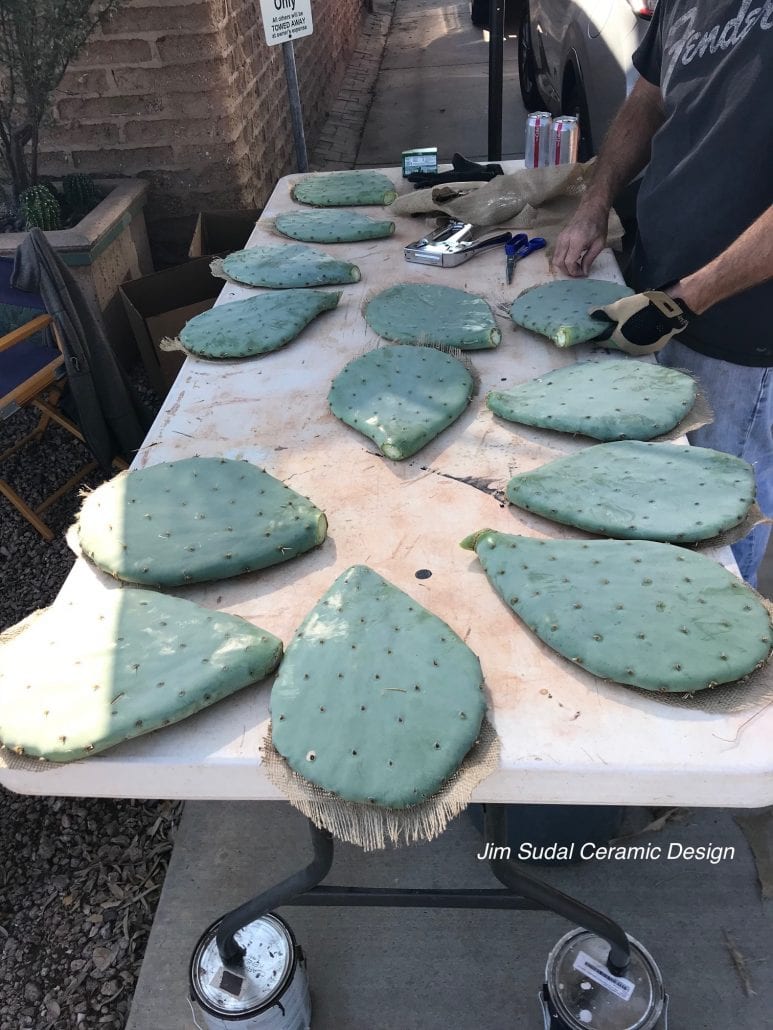
Jim Sudal’s Cactus Pad Holiday Tree
Jim Sudal's cactus pad holiday tree is a great reinterpretation of the traditional fir tree, and perfect for the dry, hot Southwest. Like Jim, many residents of Phoenix (and well beyond) have stands of prickly pear (Opuntia ficus-indica). The juicy-leaved succulent is iconic to the region. "Last year I built a garland around my gallery front door made from fresh prickly pear pads," Jim told me. "They lasted at least eight months and even started to sprout new pads."
About 250 cactus pads from Jim's garden cover the 7-foot-tall tree. He and friend Mark Faulkner spent two days assembling it on a conical iron frame wrapped with poultry fencing. "We wore special gloves called Thorn Armor that did their best to protect our hands," Jim says. The men wired each pad at its stem end, then hooked it to the frame. Jim's not planning on leaving the tree up past winter, but it has the potential to look good for at least six months.
Jim, a renowned ceramicist, gets much inspiration from succulents. He sells his work via mail order, so if you're looking for home decor items or the perfect gift for a succulent lover, do visit his site. A few of many lovely items:
Cactus tree Q&A
If you're keen to make a cactus tree or just want to know more, here's my Q-and-A with Jim.
Q: What’s the approximate diameter of the base of the tree?
A: Probably 4 ft.
Q: Did you secure the chicken wire to the frame with zip ties?
A: No, we used bailing wire.
Q: Where did you get the frame?
A: I bought the metal tree frame from a retail display company, Tripar.

Q: How and why did you remove the spines?
A: We removed some of the daunting spines, not all, with scissors to make them easier to handle and to make a bit safer for spectators who are taking pictures of themselves next to the tree.
A: We removed some of the daunting spines, not all, with scissors to make them easier to handle and to make a bit safer for spectators who are taking pictures of themselves next to the tree.
Q: What’s the cloth under each pad, and what purpose does it serve?
A: It's natural colored burlap, and it was simply an aesthetic choice to give the pads some distinction between the layers.

Q: Figure 3 lbs/pad x 250 = 750 lbs. What’s the tree standing on?
A: The tree is on one of the iron table bases I have made for making my ceramic-topped tables. We wanted to bring the tree up a bit higher above the prickly pear garden in front of my gallery. I clamped the base of the tree to the top of the table base.
A: The tree is on one of the iron table bases I have made for making my ceramic-topped tables. We wanted to bring the tree up a bit higher above the prickly pear garden in front of my gallery. I clamped the base of the tree to the top of the table base.

Q: What kind of hooks did you use?
A: We made our own hooks from bailing wire. We threaded the wire through the woody end of the pad and looped it around, twisted it and bent it into a hook.
Q: Despite wearing $50 Thorn Armor gloves, did you get poked?
A: They worked really great, but by the end of the day, they were a bit saturated with spines that eventually made their way through. They really helped. We couldn't have done it without them, but nothing is foolproof.
Q: I see that you used seed pods and gourds for the garland, but what’s the white-dotted vine?
A: It's a garland from a floral supply shop that we added natural elements to.

Q: Anything else a do-it-yourselfer should know besides “start at the bottom, overlap the pads like shingles, and use smaller pads as you go higher”?
A: That's pretty much it, except that we ended up using a lot more pads than we originally anticipated...probably by twice as many! Also, as you mentioned, it's a lot of weight so we really needed to secure the tree frame wherever we could and secure it tightly to the base.
Q: What are you going to do with all those pads when you take down the tree?
A: Being a lover of succulents and succulent gardening, the pads will come back home with me and be planted in my yard!
Enjoyed this article? Please share it!





